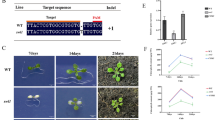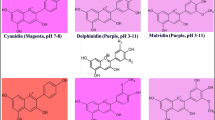Abstract
Carotenoids are red, yellow and orange pigments, which are widely distributed in nature and are especially abundant in yellow-orange fruits and vegetables and dark green leafy vegetables. Carotenoids are essential for photosynthesis and photoprotection in plant life and also have different beneficial effects in humans and animals (van den Berg et al. 2000). For example, β-carotene plays an essential role as the main dietary source of vitamin A. To obtain further insight into β-carotene biosynthesis in two important economic plant species, Lycium barbarum and Gentiana lutea L., and to investigate and prioritize potential genetic engineering targets in the pathway, the effects of five carotenogenic genes from these two species, encoding proteins including geranylgeranyl diphosphate synthase, phytoene synthase and δ-carotene desaturase gene, lycopene β-cyclase, lycopene ε-cyclase were functionally analyzed in transgenic tobacco (Nicotiana tabacum) plants. All transgenic tobacco plants constitutively expressing these genes showed enhanced β-carotene contents in their leaves and flowers to different extents. The addictive effects of co-ordinate expression of double transgenes have also been investigated.




Similar content being viewed by others
References
Al-Babili S, Beyer P (2005) Golden Rice—five years on the road—five years to go? Trends Plant Sci 10:565–573
Bramley P, Teulieres C, Blain I, Bird C, Schuch W (1992) Biochemical characterization of transgenic tomato plants in which carotenoid synthesis has been inhibited through the expression of antisense RNA to pTOM5. Plant J 2:343–349
Cunningham FX, Gantt E (1998) Genes and enzymes of carotenoid biosynthesis in plants. Annu Rev Plant Phys 49:557–583
Cunningham FX, Pogson B, Sun Z, McDonald KA, DellaPenna D, Gantt E (1996) Functional analysis of the β and ε-lycopene cyclase enzymes of Arabidopsis reveals a mechanism for control of cyclic carotenoid formation. Plant Cell 8:1613–1626
D’Ambrosio C, Giorio G, Marino I, Merendino A, Petrozza A, Salfi L, Stigliani AL, Cellini F (2004) Virtually complete conversion of lycopene into beta-carotene in fruits of tomato plants transformed with the tomato lycopene beta-cyclase (tlcy-b) cDNA. Plant Sci 166:207–214
DellaPenna D (1999) Nutritional genomics: manipulating plant micronutrients to improve human health. Science 285:375–379
Demmimg-Adam B, Adams WW (1996) The role of xanthophylls cycle carotenoids in the protection of photosynthesis. Trends Plant Sci 1:21–26
Forkmann G, Martens S (2001) Metabolic engineering and application of flavonoids. Curr Opin Biotechnol 12:155–160
Fray RG, Wallace A, Fraser PD, Valero D, Hedden P, Bramley PM, Grierson D (1995) Constitutive expression of a fruit phytoene synthase gene in transgenic tomatoes causes dwarfism by redirecting metabolites from the gibberellin pathway. Plant J 8:693–701
Hirschberg J (1999) Production of high-value compounds: carotenoids and vitamin E. Curr Opin Biotechnol 10:186–191
Hirschberg J (2001) Carotenoid biosynthesis in flowering plants. Curr Opin Plant Biol 4:210–218
Mayne ST (1996) Beta-carotene, carotenoids, and disease prevention in humans. FESEB J 10:690–701
Paine JA, Shipton CA, Chaggar S, Howells RM, Kennedy MJ, Vernon G, Wright SY, Hinchliffe E, Adams JL, Silverstone AL, Drake R (2005) Improving the nutritional value of Golden Rice through increased pro-vitamin A content. Nat Biotechnol 23:482–487
Romer S, Fraser PD, Kiano JW, Shipton CA, Misawa N, Schuch W, Bramley PM (2000) Elevation of the provitamin A content of transgenic tomato plants. Nat Biotechnol 18:666–669
Ronen G, Cohen M, Zamir D, Hirschberg J (1999) Regulation of carotenoid biosynthesis during tomato fruit development: expression of the gene for lycopene epsilon-cyclase is down-regulated during ripening and is elevated in the mutant Delta. Plant J 17:341–351
Rosati C, Aquilani R, Dharmapuri S, Pallara P, Marusic C, Tavazza R, Bouvier F, Camara B, Giuliano G (2000) Metabolic engineering of beta-carotene and lycopene content in tomato fruit. Plant J 24:413–419
Sambrook J, Fritsch EF, Maniatis T (1989) Molecular cloning: a laboratory manual. Cold Spring Harbor Laboratory Press, USA
Sandmann G (2001) Carotenoid biosynthesis and biotechnological application. Arch Biochem Biophys 385:4–12
Schmidt-Dannert C (2000) Engineering novel carotenoids in microorganisms. Curr Opin Biotechnol 11:255–261
Shewmaker CK, Sheehy JA, Daley M, Colburn S, Ke DY (1999a) Seed-specific overexpression of phytoene synthase: increase in carotenoids and other metabolic effects. Plant J 20:401–412
Shewmaker CK, Sheehy JA, Daley M, Colburn S, Ke DY (1999b) Seed-specific overexpression of phytoene synthase: increase in carotenoids and other metabolic effects. Plant J 20:401–412
Siefermann-Harms D (1987) The light-harvesting and protective functions of carotenoids in photosynthetic membranes. Physiol Planta 69:561–568
Suzuki S, Nishihara M, Nakatsuka T, Misawa N, Ogiwara I, Yamamura S (2007) Flower color alteration in Lotus japonicus by modification of the carotenoid biosynthetic pathway. Plant Cell Rep 26:951–959
Tanaka Y, Tsuda S, Kusumi T (1998) Metabolic engineering to modify flower color. Plant Cell Physiol 39:1119–1126
van den Berg H, Faulks R, Granado HF, Hirschberg J, Olmedilla B, Sandmann G, Southon S, Stahl W (2000) The potential for the improvement of carotenoid levels in foods and the likely systemic effects. J Sci Food Agric 80:880–912
Ye XD, Al-Babili S, Kloti A, Zhang J, Lucca P, Beyer P, Potrykus I (2000) Engineering the provitamin A (beta-carotene) biosynthetic pathway into (carotenoid-free) rice endosperm. Science 287:303–305
Zaripheh S, Erdman JW (2002) Factors that influence the bioavailablity of xanthophylls. J Nutr 132:531–534
Acknowledgements
This work was supported by three grants and the funding numbers are 06YFGZNC01700, 2006GB2A100013 and 04260.
Author information
Authors and Affiliations
Corresponding author
Rights and permissions
About this article
Cite this article
Ji, J., Wang, G., Wang, J. et al. Functional analysis of multiple carotenogenic genes from Lycium barbarum and Gentiana lutea L. for their effects on β-carotene production in transgenic tobacco. Biotechnol Lett 31, 305–312 (2009). https://doi.org/10.1007/s10529-008-9861-8
Received:
Revised:
Accepted:
Published:
Issue Date:
DOI: https://doi.org/10.1007/s10529-008-9861-8




